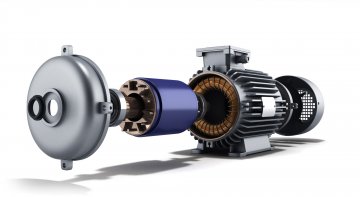Electric Motor maintenance: Market Overview, Common Errors, Future Sensors
Electric motors are the basic inherent part of industrial production as well as of home appliances, HVAC (Heating, Ventilation, and Air Conditioning), motor vehicles, and other applications. The use of electric motors is expected to grow significantly in the next years. The annual growth of the use of electric motors in new and already penetrated sectors creates pressure on their effectiveness and new functionalities (e.g. IoT integration, Smart Motors).
The lack of efficiency and new functionalities present themself in different forms of errors, that take place in the individual motors depending on their usage, surroundings, installation, in one word – the maintenance
Electric motor maintenance: Common causes, available practices
Let’s look into multiple groups of main issues with electric motors and identify possible solutions to achieve effective maintenance.
As for any mechanical device, it is natural for an electric motor to be exposed to a range of issues causing malfunctions. Due to the importance of electric motors, especially in industrial, mobility, and even consumer products – their malfunctions or failures cause negative affect the whole process of a company or a product, thus the customer is pressured to implement reactive solutions, which, frankly speaking, is not the most economically viable option.
Reacting to an already-occurred obstacle, one does not have enough time to make the most efficient decision. The user has to rather quickly replace or fix the failed motor (reactive maintenance). This nor increases the potential competitive advantage neither terminates the fact that the motor will malfunction again because this motor will need to be used with the same workload, in order to bring the same results.
Companies lose millions every day because of the unpredicted failure of electric motors. On a large scale, the swift reaction of replacing malfunctioning motors with the same ones, or just fixing them, eventually slows down the development of the industry as such (slow automation, slow growth of large companies, naturally slows regional development in the sector).
Taking a step back, and looking at the Motor Failures is a simple way to eventually identify a set of decisions that would serve as proper solutions with solid ROI.
Let’s look into multiple groups of main issues with the motors and identify possible solutions.
*If you want to find out why is a smart electric motor key enabler of energy efficiency, read one of our older articles
Fatigue of the motor components
First and foremost, the bearings are fundamental parts of the functioning of an electric motor. Even in case of failure of one of the bearings, a chain of negative effects can accrue such as overheating, lubrication issues, and increased drag.
There are numerous causes of bearing fatigue or any other bearing issues, some of the most common ones are excessive load management, misfits, misalignment, etc. According to experts, up to 13 % of motor failures accrue due to bearing errors.
Vibrations
Vibrations as such take place for various reasons, other than bearing-related ones, such as
- misalignment/inbalance in the application where the motor is used;
- the shafts getting out of line (i.e. out of supposed parallel alignment);
- wear and tear of the components (ball or roller bearings, drive belts or gears, gear tooth that is heavily chipped).
Knowledge of early-stage vibration anomalies in the motor (bearing damage will cause uncontrolled, immoderate vibrations within the motor) is a huge competitive advantage for making the motor lifetime longer. The faster these vibration anomalies are detected – the easier it is to conduct maintenance activity.
Overheating
An electric motor is essentially a device that turns electric input into mechanical energy. This process naturally generates heat during operation. It is a standard process and usually, some heat emission is natural, it should not cause any alarm. However, excessive overheating can occur and even cause damage in addition to deterioration of the components that are housed within the motor itself. The most common reason being operational overload.
When a motor is being used in higher pressure conditions than it is designed for, overheating may occur. Even a few degrees of additional heat within the motor can be enough to wear out some of the essential components (i.e. rotor/bearing).
Input/Output issues
Voltage Spikes
To deliver the designed output mechanical energy, a certain electrical power needs to be inputted into the motor. Should this power exceed the designed amount, the motor accordingly exceeds its limits, naturally placing risks of malfunction. These are often called voltage spikes (a.k.a. power surge).
Harmonic Distortion
High-frequency AC volts as such may compromise the motor effectivity and the whole basic performance as such. Harmonics are essentially electric voltages/currents that can raise a significant drawback for the electrical system as the motor cannot use extra energy effectively. The system is unbalanced, the extra energy reflects on the windings and bearings, causing energy losses, and finally a decrease in a motor lifetime.
Reduce harmonic distortion by installing a variable frequency drive, or you can try using a filter to help keep harmonic distortion damage to a minimum.
Harsh, unfitting physical environment
- Restricted Ventilation: Covering the motor’s enclosure can result in the motor overheating.
- Improper Lubrication: Not only can this result in damaged bearings but can also throw grease into windings.
- Moisture: Condensation can cause rust within an enclosed motor.
- Vibration, Belt Tension, and Misalignment: All three can shorten the life of a motor if not corrected.
- High Ambient Temperatures: Consider derating to a lower power load if your motr temperature goes above its specified limits, or, install a motor designed with proper insulation for operation at higher ambient temperatures.
- Condemnation: Condemnation is a usual cause of failure for electric motors, especially for the bearings. It may appear when foreign substances work their way into cleaning solutions or bearing lubricants. Dust, dirt, abrasive materials, and small particles of metal, such as steel, can find their way into the electric motor from other machinery(or directly from the motor as a result of wear and rear), contaminated tools, or if the motor is handled by technicians with dirty hands. Denting in the raceways and rolling elements and vibrations indicate motor bearing failure due to contamination.
Electric Motor Sensing system: Future is tiny
The motors are usually able to reach certain operational heights to carry out especially demanding tasks, however, these are not designed to be used at those operational pressures at all times. This surely compromises the performance and decreases the lifetime of a motor.
After a long back and forth the industry is naturally claiming that the key to keeping the electric motor applications running smoothly, and getting the maximum capacity for the longest time possible is to practice long-term preventive and predictive maintenance. Surely there are various solutions (per each above-mentioned issue), however, we try to introduce one that helps make the electric motors safer, more efficient, and overall – intelligent, with just one system.
This solution lies in the MicroWire, a miniaturized sensor of physical quantities that can provide data about the physical environment of the motor, directly from within!
This data (electric current, temperature, vibrations, pressure) is gathered in real-time, and due to the miniaturized size of the MicroWire sensor – there are minimum or no additional design changes needed to gather real-time information about the motor directly from the local environment of interest (i.e. MicroWire can be attached to the bearings and provide real-time data of Vibrations, Pressure, Temperature etc.).
Market research within the Machine Learning and Artificial Intelligence industries states that the time, finances and the final quality of these – first and foremost depend on the precision and appropriate quantity of the data. The form of the data gathered via RVmagnetics MicroWire sensors is up to the customer. It can be adjusted to the software in place, as the system can gather data with up to 10.000×/sec frequency, with extremely high precision.
Considering the accuracy of the MicroWire sensors – we essentially make it clear the roadmap to Motor Maintenance, not only to maximize efficiency and lifetime of the system but also to ensure the safety of the environment where the motor is used.
There is an obvious benefit in motor efficiency for the businesses that use electric motors in some form of their applications, but what is not less important to mention is the environmental, global impact that a more efficient electric motor can have. Electric motors emit a total of 6,800 metric tons of carbon dioxide in a year. A transition to energy-efficient motor systems would reduce the global electricity demand for electric motors by around 20% to 30% by 2030.
By using more efficient motors, countries can save 300 TWh per year of electricity in 2030, saving 200 Mt of CO2 emissions—equivalent to the annual electricity generated by approximately 60 coal-fired power plants with a capacity of 1,000 MW.



